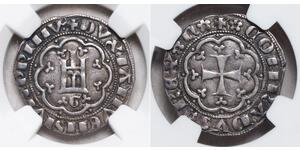3 Mark (sold for $118.0)
1915, Saxe-Weimar-Eisenach. Silver 3 Mark "Grand Duchy Centenary Coin. XF+
Mint Year: 1915 Reference: KM-1266. Denomination: 5 Mark Condition: Toned and cleaned (hairlines), minor contact-marks, otherwise XF+ Material: Silver (.900) Weight: 16,66gm Diameter: 33mm
Obverse: Conjoined uniformed busts of Wilhelm Ernst and Carl August of Saxe-Weimar-Eisenach right. Mint initial (A) below. Legend: WILHELM ERNST MCMXV CARL AUGUST MDCCCXV Reverse: Crown above heraldic eagle with shield with coat-of-arms at chest. Legend: DEUTSCHES REICH * 1915 * DREI MARK
Saxe-Weimar-Eisenach (German: Sachsen-Weimar-Eisenach) was created as a duchy in 1809 by the merger of the Ernestine duchies of Saxe-Weimar and Saxe-Eisenach, which had been in personal union since 1741. It was raised to a Grand duchy in 1815 by resolution of the Vienna Congress. In 1903, it officially changed its name to the Grand Duchy of Saxony (German: Großherzogtum Sachsen), but this name was rarely used. The Grand Duchy came to an end in the German Revolution of 1918–19 with the other monarchies of the German Empire. It was succeeded by the Free State of Saxe-Weimar-Eisenach, which was merged into the new state of Thuringia two years later. The full grand ducal style was Grand Duke of Saxe-Weimar-Eisenach, Landgrave in Thuringia, Margrave of Meissen, Princely Count of Henneberg, Lord of Blankenhayn, Neustadt and Tautenburg. The Saxe-Weimar-Eisenach branch is the most genealogically senior extant branch of the House of Wettin since 1672.
em>.
Wilhelm Ernst Karl Alexander Friedrich Heinrich Bernhard Albert Georg Hermann (English: William Ernest Charles Alexander Frederick Henry Bernard Albert George Herman) (10 June 1876 – 24 April 1923) was the last Grand Duke of Saxe-Weimar-Eisenach.
He was born in Weimar, the eldest son of Karl August of Saxe-Weimar-Eisenach, heir to the Grand Duke, and his wife Princess Pauline of Saxe-Weimar-Eisenach.
He succeeded his grandfather Karl Alexander as Grand Duke on 5 January 1901, as his father had predeceased him.
His heir was a distant cousin, Prince Hermann of Saxe-Weimar-Eisenach, until his disinheritance in 1909. Hermann's younger brother subsequently served as heir presumptive to the Duchy of Saxe-Weimar-Eisenach until the birth of William Ernest's eldest son.
Wilhelm Ernst created the new Weimar town center under the direction of Hans Olde, Henry van de Velde, and Adolf Brütt. Also, he also had the University of Jena rebuilt by Theodor Fischer, and also reconstructed Weimar's theatres. The improvements to the city included a marble statue of his predecessor Charles Alexander, which was completed in 1911. It was placed in a setting designed by Brütt. The placement of the setting was designed to distinguish the "old town" from the newly built area. A preservation law for the "old town" barred it to the "art nouveau"-style which was used in the new area.
According to the Dutch constitution, Wilhelm Ernst was in the line for the throne of the Netherlands (as the grandson of Princess Sophie of the Netherlands) after Queen Wilhelmina. At the beginning of the 20th century, the Dutch feared the possibility of German influence or even annexation of the Netherlands. In order to prevent this, some lawyers tried to change the constitution to exclude Wilhelm Ernst from the succession. Another proposal, however, was this: if Wilhelmina would die childless, then he or his offspring would have to choose between the Dutch and the Weimar throne. The birth of Wilhelmina's daughter Juliana in 1909 lessened the chance for any member of the house of Wettin (Saxe-Weimar-Eisenach branch) to inherit the Dutch throne. With the amendment to the constitution of 1922, which restricted the right of succession to the offspring of Wilhelmina, the possibility disappeared entirely.
On 9 November 1918 Wilhelm Ernst - along with the rest of the German monarchs following the defeat of Germany in World War I - was forced to abdicate. His throne and all his lands were relinquished and he fled with his family to the family estate in Silesia, where he died five years later.
Despite all his work for Weimar during his government, Wilhelm Ernst was a hated ruler. This was for his private life, where he was known to be a sadist; the day of his abdication, he was called the "most unpopular prince in all Germany".
He died in Heinrichau in Silesia.
Only 1$ shipping for each additional item purchased!

|
Posted by:
anonymous 2018-05-18 |
|
||
|
||
|
||
|
||
|
||
2 Corona Austria-Hungary (1867-1918) Silver
group has 12 coins / 9 prices
⇑

-600-300-CiAKqUpYoQwAAAFjCidEJHHX.jpg)

-300-150-w9QKbzbisI8AAAFPQlqA8Is4.jpg)
 Русский
Русский






-300-150-piIR018gFOsAAAGLlwDsXZhV.jpg)






